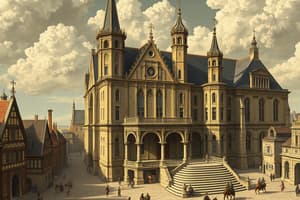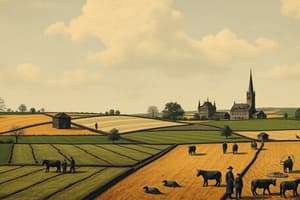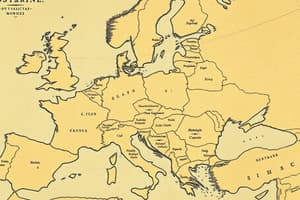Podcast
Questions and Answers
What significant educational program was incorporated with physical education in high schools during the 70s and early 80s?
What significant educational program was incorporated with physical education in high schools during the 70s and early 80s?
- Health Education Initiative
- Literacy Advancement Program
- Youth Development Training (correct)
- Performance Arts Curriculum
Which program was revised in 1971 to include a variety of physical activities for elementary students?
Which program was revised in 1971 to include a variety of physical activities for elementary students?
- Sports Ethics Program
- Physical Education Program (correct)
- New Elementary School Curriculum
- Testing Program
In Grades I and II, how is physical education taught according to the New Elementary School Curriculum?
In Grades I and II, how is physical education taught according to the New Elementary School Curriculum?
- Integrated with Sibika at Kultura (correct)
- During extracurricular activities only
- As a standalone subject with fixed hours
- As a part of Science curriculum only
What is the title of the subject that combines physical education, arts, and music for Grades III to VI?
What is the title of the subject that combines physical education, arts, and music for Grades III to VI?
What educational initiative was introduced through MEC Order No. 6, s. 1982?
What educational initiative was introduced through MEC Order No. 6, s. 1982?
What does the Secondary Education Development Program (SEDP) emphasize based on DECS Order No. 11, s. 1989?
What does the Secondary Education Development Program (SEDP) emphasize based on DECS Order No. 11, s. 1989?
How often is physical education taught in public elementary schools for Grades I and II starting from 1994?
How often is physical education taught in public elementary schools for Grades I and II starting from 1994?
Which subject area is included in the New Secondary Education Curriculum (NSEC)?
Which subject area is included in the New Secondary Education Curriculum (NSEC)?
What recreational pastime was similar to bowling?
What recreational pastime was similar to bowling?
Which philosopher embraced the idea of physical fitness promoting social and moral well-being?
Which philosopher embraced the idea of physical fitness promoting social and moral well-being?
Which activity was NOT part of the physical education program during the Renaissance period?
Which activity was NOT part of the physical education program during the Renaissance period?
Who is considered the 'father' of the modern educational practice including sports in schools?
Who is considered the 'father' of the modern educational practice including sports in schools?
What term refers to the idea of a 'universal man' that influenced physical education during the Renaissance?
What term refers to the idea of a 'universal man' that influenced physical education during the Renaissance?
Which figure believed physical education served as a rest from other learning processes?
Which figure believed physical education served as a rest from other learning processes?
What was one of the aims of the programs of physical activities during the Renaissance?
What was one of the aims of the programs of physical activities during the Renaissance?
Which of the following was a belief of John Locke regarding physical education?
Which of the following was a belief of John Locke regarding physical education?
What was the primary purpose of military skills in ancient Persia?
What was the primary purpose of military skills in ancient Persia?
What activity was considered to be one of the oldest forms of organized dancing in India?
What activity was considered to be one of the oldest forms of organized dancing in India?
Which physical activity in ancient China was designed to prevent diseases?
Which physical activity in ancient China was designed to prevent diseases?
What type of athletes did the Greeks highly respect in terms of competition?
What type of athletes did the Greeks highly respect in terms of competition?
At what age did Spartan boys begin their compulsory training known as Agoge?
At what age did Spartan boys begin their compulsory training known as Agoge?
Which of the following activities was NOT prevalent in ancient Egyptian culture?
Which of the following activities was NOT prevalent in ancient Egyptian culture?
What did Plato believe was beneficial for educating the body and soul?
What did Plato believe was beneficial for educating the body and soul?
In what way was physical education significant in Athens?
In what way was physical education significant in Athens?
What did ARISTOTLE believe about athletics?
What did ARISTOTLE believe about athletics?
What was HIPPOCRATES' law of use regarding physical activity?
What was HIPPOCRATES' law of use regarding physical activity?
How did the Romans primarily view physical activities?
How did the Romans primarily view physical activities?
What was the significance of Campus Martinus in Roman military training?
What was the significance of Campus Martinus in Roman military training?
What led to the neglect of physical health and exercise during the Roman Empire's decline?
What led to the neglect of physical health and exercise during the Roman Empire's decline?
What role did the Christian Church play in physical activities during the Middle Ages?
What role did the Christian Church play in physical activities during the Middle Ages?
What two philosophies influenced attitudes towards physical activity in the Middle Ages?
What two philosophies influenced attitudes towards physical activity in the Middle Ages?
What were ball games allowed on, during the Middle Ages?
What were ball games allowed on, during the Middle Ages?
What is the primary focus of cognitive learning in physical education?
What is the primary focus of cognitive learning in physical education?
Which stage of learning involves the learner trying to understand the goal of the activity?
Which stage of learning involves the learner trying to understand the goal of the activity?
Motor control is primarily concerned with which of the following?
Motor control is primarily concerned with which of the following?
Which of the following components is NOT part of the information-processing approach?
Which of the following components is NOT part of the information-processing approach?
What is the focus of affective learning in physical education?
What is the focus of affective learning in physical education?
When a learner refines the basics of a skill, which stage of learning are they in?
When a learner refines the basics of a skill, which stage of learning are they in?
What role does feedback play in the motor learning process?
What role does feedback play in the motor learning process?
What aspect does psychomotor learning focus on in physical education?
What aspect does psychomotor learning focus on in physical education?
Flashcards are hidden until you start studying
Study Notes
Physical Education Legislative Framework
- The Schools Physical Education and Sports Act of 1969 introduced a comprehensive program in schools encompassing health education, nutrition, physical fitness, competitive athletics, and annual inter-regional competitions.
- Physical education (PE) was integrated into Youth Development Training (YDT) in high schools during the 1970s and early 1980s, along with subjects like Scouting, Health, and Music.
- A revised PE program for elementary schools implemented in 1971 included activities such as games, relays, swimming, and programs for students needing special attention.
Curriculum Developments in Education
- The Revised Secondary School Program was formalized under Department Order No. 20, s. 1973, introducing YDT and Citizen Army Training (CAT).
- MEC Order No. 6, s. 1982 presented the New Elementary School Curriculum (NESC) reflecting educational changes under the Program for Decentralized Educational Development (PRODED).
- PE for Grades I and II was integrated with Civics, while Grades III to VI paired PE with Art and Music to form Music, Art and Physical Education (MAPE).
Evolution of Secondary Education
- The 1989 Secondary Education Development Program (SEDP) aimed to sustain student development initiated by PRODED, establishing a cognitive-affective-manipulative approach.
- The New Secondary Education Curriculum (NSEC) included Physical Education, Health, and Music (PEHM) as one of its eight subject areas.
- By DECS Order No. 53, s. 1994, PE for Grades I and II became a separate daily subject starting the school year 1994-1995, while maintaining integration within MAPE for older grades.
Historical Context of Physical Education Globally
- In ancient civilizations like Egypt, Greece, and China, various forms of physical activities such as swimming, wrestling, and martial arts were practiced for health and military training.
- The Greeks valued physical education as essential for developing courage, discipline, and aesthetic values, with gymnasiums playing a key role in training boys.
- Spartan education emphasized rigorous physical training through the Agoge system, focusing on physical fitness and military skills.
Educational Philosophers and Physical Education
- Philosophers such as Plato and Aristotle recognized the importance of physical education in promoting holistic development, linking it to mental and moral education.
- Hippocrates noted that physical activity reinforces bodily functions, while scholars like St. Thomas Aquinas promoted physical fitness for moral and social benefits.
Impact of the Roman Empire on Physical Culture
- Romans built public baths (thermae) to promote health through exercise, yet their preference for entertainment led to a decline in formal athletics.
- The focus on gladiatorial games and spectacles resulted in a culture of spectatorship, diminishing the value placed on physical activity and contributing to societal decay.
Physical Activities during the Middle Ages
- The fall of the Roman Empire led to the church becoming the primary institution influencing physical culture, albeit with limited PE inclusion in education.
- Recreational activities among nobility included hunting, royal tennis, and games promoting physical fitness as part of chivalric training.
Renaissance and Modern Physical Education
- The Renaissance period fostered the value of physical health, emphasizing the need for physical development for learning and military readiness.
- Initiatives like those by Petrus Paulus Vergerius and educational thinkers like Richard Mulcaster recognized the essential role of PE in a well-rounded education.
Learning Domains in Physical Education
- Physical education transcends fitness by integrating cognitive (knowledge), affective (attitudes), and psychomotor (skills) learning domains.
- Motor learning focuses on acquiring movement skills through practice, influenced by factors like motor control and motor development over one's lifespan.
Information-Processing Model in Skill Acquisition
- Skill acquisition involves four key components: input (instruction), decision-making (processing information), output (execution), and feedback (performance assessment).
- Learning progresses through three stages: cognitive (understanding the skill), associative (refining skills through practice), and autonomous (performing with minimal thought).
Studying That Suits You
Use AI to generate personalized quizzes and flashcards to suit your learning preferences.




